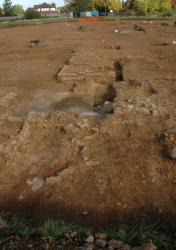13 JANVIER
INDI-UNI : ANTHROPOLOGY - ARCHAEOLOGY
INSCRIPTION 2012 COURS A DISTANCE
REGISTRATION 2012 ONLINE COURSES
USA – North Charleston - Confederate Civil War vessel H.L. Hunley, the world's first successful combat submarine, was unveiled in full and unobstructed for the first time on Thursday, capping a decade of careful preservation. About 20 engineers and scientists applauded as they caught the first glimpse of the intact 42-foot-long (13-meter-long) narrow iron cylinder, which was raised from the ocean floor near Charleston more than a decade ago. Considered the Confederacy's stealth weapon, the Hunley sank the Union warship Housatonic in the winter of 1864, and then disappeared with all eight Confederate sailors inside. The narrow, top-secret "torpedo fish," built in Mobile, Ala., by Horace Hunley from cast iron and wrought iron with a hand-cranked propeller, arrived in Charleston in 1863 while the city was under siege by Union troops and ships. In the ensuing few months, it sank twice after sea trial accidents, killing 13 crew members, including Horace Hunley, who was steering. "There are historical references that the bodies of one crew had to be cut into pieces to remove them from the submarine," Mardikian told Reuters. "There was forensic evidence when they found the bones (between 1993 and 2004 in a Confederate graveyard beneath a football stadium in Charleston) that that was true." The Confederate Navy hauled the sub up twice, recovered the bodies of the crew, and planned a winter attack. On the night of Feb. 17, 1864, its captain and seven crew left Sullivan's Island near Charleston, and hand-powered the sub to the Union warship four miles (6.4 kilometers) offshore. From a metal spar on its bow, the Hunley planted a 135-pound (61-kilogram) torpedo in the hull of the ship, which burned and sank.
North Charleston - Confederate Civil War vessel H.L. Hunley, the world's first successful combat submarine, was unveiled in full and unobstructed for the first time on Thursday, capping a decade of careful preservation. About 20 engineers and scientists applauded as they caught the first glimpse of the intact 42-foot-long (13-meter-long) narrow iron cylinder, which was raised from the ocean floor near Charleston more than a decade ago. Considered the Confederacy's stealth weapon, the Hunley sank the Union warship Housatonic in the winter of 1864, and then disappeared with all eight Confederate sailors inside. The narrow, top-secret "torpedo fish," built in Mobile, Ala., by Horace Hunley from cast iron and wrought iron with a hand-cranked propeller, arrived in Charleston in 1863 while the city was under siege by Union troops and ships. In the ensuing few months, it sank twice after sea trial accidents, killing 13 crew members, including Horace Hunley, who was steering. "There are historical references that the bodies of one crew had to be cut into pieces to remove them from the submarine," Mardikian told Reuters. "There was forensic evidence when they found the bones (between 1993 and 2004 in a Confederate graveyard beneath a football stadium in Charleston) that that was true." The Confederate Navy hauled the sub up twice, recovered the bodies of the crew, and planned a winter attack. On the night of Feb. 17, 1864, its captain and seven crew left Sullivan's Island near Charleston, and hand-powered the sub to the Union warship four miles (6.4 kilometers) offshore. From a metal spar on its bow, the Hunley planted a 135-pound (61-kilogram) torpedo in the hull of the ship, which burned and sank.
http://www.msnbc.msn.com/id/45980970/ns/technology_and_science-science/#.TxB7y29vsyp
ROYAUME UNI –  Peterborough – Peterborough’s history books are set to be rewritten after a stunning Roman villa was found by archaeologists in Itter Cresent. The villa, which was the site of a large farm, was dicovered when developers planned to build homes on the site. Now city historians are having to re-examine everything they thought they knew about the city as it looked 2,000 years ago. Dr Rebecca Casa Hatton, Peterborough City Council archaeologist, said : “Even allowing for damage caused by the expansion of the town, evidence for Roman occupation in Peterborough is scanty, almost giving the impression that the important people passed through but did not want to stay. “By contrast, the site at Itter Crescent indicates that some 2,000 years ago members of the higher classes of Roman society came, stayed and made a statement of wealth and status at this very location.” Archaeologists were able to tell that the historic villa was used by wealthy Romans because of the facilities discovered. “Underneath the villa was an Iron age settlement, dating back to 100BC. It is possible that the Roman villa was built for an Iron Age chief. “The villa was taken apart by us while we got down to the Iron Age site, so there is nothing left on the site now. “This discovery allows us to look at the possible locations of roads and communication networks in the area at the time.” The find includes remains of a substantial, two-floor courtyard limestone villa with rooms floored with mosaic on the sides of a cobbled courtyard. Its residents enjoyed bathing in a hot and sauna-like bath, as indicated by the remains of the sweating chambers and under-floor heating system. A range of stone-built buildings was located to the north. Further buildings, also decorated with painted wall plaster, lie to the east and a tile kiln in a small stone structure is to the west.
Peterborough – Peterborough’s history books are set to be rewritten after a stunning Roman villa was found by archaeologists in Itter Cresent. The villa, which was the site of a large farm, was dicovered when developers planned to build homes on the site. Now city historians are having to re-examine everything they thought they knew about the city as it looked 2,000 years ago. Dr Rebecca Casa Hatton, Peterborough City Council archaeologist, said : “Even allowing for damage caused by the expansion of the town, evidence for Roman occupation in Peterborough is scanty, almost giving the impression that the important people passed through but did not want to stay. “By contrast, the site at Itter Crescent indicates that some 2,000 years ago members of the higher classes of Roman society came, stayed and made a statement of wealth and status at this very location.” Archaeologists were able to tell that the historic villa was used by wealthy Romans because of the facilities discovered. “Underneath the villa was an Iron age settlement, dating back to 100BC. It is possible that the Roman villa was built for an Iron Age chief. “The villa was taken apart by us while we got down to the Iron Age site, so there is nothing left on the site now. “This discovery allows us to look at the possible locations of roads and communication networks in the area at the time.” The find includes remains of a substantial, two-floor courtyard limestone villa with rooms floored with mosaic on the sides of a cobbled courtyard. Its residents enjoyed bathing in a hot and sauna-like bath, as indicated by the remains of the sweating chambers and under-floor heating system. A range of stone-built buildings was located to the north. Further buildings, also decorated with painted wall plaster, lie to the east and a tile kiln in a small stone structure is to the west.
http://www.peterboroughtoday.co.uk/news/local/peterborough_s_past_rewritten_by_roman_villa_discovery_1_3414573
INDE - Munjuluru - A Buddhist Stupa site was discovered in Munjuluru Village, Bantumilli Manda, Krishna District, Andhra Pradesh by the State Department of Archaeology, Govt. of Andhra Pradesh in 2010 consisting of a hemispherical mound about 10 meters height with rectangular projections at the base on four cordinal directions found in the Village Munjuluru in an extent of 43 cms. The brick size measures 27x23x7 cms. in the surrounding areas of the mound noticed black and red ware, buff along with conch shells. Broken Ayaka Pillar of lime stone and pitha datable to 5th – 6th century A.D. were also noticed. The State Department of Archaeology & Museums, Govt. of Andhra Pradesh has issued the Notification No.G.O.Ms.No.64, YAT &C (PMU) Deptt., dated 16th June, 2011 for protecting the said ancient monument.
http://pib.nic.in/newsite/erelease.aspx?relid=79553
USA – New Orleans - An empty lot in the 900 block of Conti St. is full of history. UNO archaeologist Andrea White says she's reading the ground there like a diary. "We're doing an archaeological and scientific investigation at the property to understand the people who lived here before us," she said. White is digging for her idea of Gold at 933 Conti. A new Irish Channel Cultural Museum will soon be built on the site. White says the house that was on the property in the 1800's was a Creole cottage, owned by John McDonogh. It was believed to be rented to others. "We actually have a brick pier in this corner right here, so those are some of the features of this house," said White as she pointed to a brick pillar underground. She says the property had more than 16 owners since 1777, but the people who lived on the property are harder to trace.
http://www.fox8live.com/news/local/story/Archaeologists-dig-into-French-Quarter/SdlJbNo_Xkm9RR7_2SKYIA.cspx
ISRAËL - Jerusalem - Next week, the Armstrong International Cultural Foundation presents “Seals of Jeremiah’s Captors Discovered!” The archaeology exhibit features two of the most important artifacts ever found in Jerusalem—clay seals bearing the names of two princes who persecuted the Prophet Jeremiah during the last days of the kingdom of Judah. The relationship between these two bullae—discovered by Dr. Eilat Mazar in 2005 and 2007—and the biblical account in Jeremiah 37 and 38 is nothing short of remarkable. Jeremiah’s life and work is one of the most fascinating accounts in the Bible. He pleaded with the people of Judah to consider their sinful ways and to repent. He delivered his prophetic warning to the very highest levels of Judah’s monarchy. The inscriptions on those two bullae are not the names of some insignificant commoners. They were members of Judah’s royal court—people who heard Jeremiah’s prophetic message and then rejected it, which led to Judah’s captivity in Babylon.
http://www.thetrumpet.com/?q=9011.7795.0.0